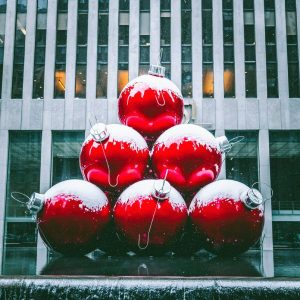Think Outside the Tree: Holiday Displays That Break the Traditional Mold

During the economic uncertainty of the pandemic years, interiorscape revenue was stagnant, but my holiday season thrived like never before. Now, with more businesses increasing their holiday budgets, it’s the perfect time to incorporate a variety of holiday displays that capture traditional themes while also appealing to the nontraditional client.
A Holiday Décor Lesson
One of my accounts has a massive atrium lobby divided into two symmetrical, multi-level plant beds. In past holiday seasons, I tried to encourage this client to expand beyond their usual holiday installs. I suggested options like Christmas tree groupings and snow-covered forest scenes, but they always stuck to window wreaths and two matching topiaries. I couldn’t understand why the building owner kept the décor so sparse in such a vast corporate lobby, but I just assumed it was a financial decision. By the fourth year, after they invested thousands in an atrium redesign, I finally asked why they didn’t want a more impressive holiday display. The building manager explained that the owner didn’t celebrate Christmas, and that’s when I realized how ignorant I had been.
Every holiday client wants their own blend of traditional and nontraditional themes. For example, one of my Jewish clients requests a Christmas tree for the lobby, with the only requirement being no red and green décor. Similarly, many of my traditional holiday accounts include additional elements like a menorah or Kwanzaa display as part of the contract. Over the years, I’ve learned the importance of understanding each client’s décor preferences rather than assuming their design choices. With that in mind, here are some nontraditional holiday displays that have appealed to all types of clientele.
Artful Topiary Designs
In lieu of a Christmas tree, a topiary can be a great alternative, with shapes like spirals, cones, and ball or triple-ball designs. I like to use a tall planter as the base, which makes the topiary look more impressive. To keep costs down, consider adding your own lights instead of buying pre-lit options. I recommend investing in LEDs—which last much longer—and ensuring the string length provides even coverage from the top of the topiary to the stem. It took me a few tries to find the best light count, but I discovered that strings with 100 to 300 lights work well.
Decorative Gift Box Displays
Many cultures exchange gifts during the holiday season, making gift box décor a safe bet. Instead of placing presents under a tree, you can skip the tree entirely and use the gift boxes as a statement piece. While some interior design vendors offer large-scale, light-up gift box décor made of fiberglass, the price can be steep, and convincing a client to invest can be challenging. For budget-conscious clients who love the look, I make my own giant gift boxes using thin board wrapped in cotton batting. To ensure the boxes hold up over time, I cover them in shiny foil or cloth instead of standard wrapping paper, which tears too easily. A four-foot-high gift box, with smaller boxes stacked on top, makes a great photo backdrop.
Oversized Holiday Ornaments

This past year, oversized floor ornaments became a popular choice with my clients. Standalone ornaments—two feet or more in diameter—range widely in price, from hundreds of dollars to as low as twenty. The high-end versions are made of durable fiberglass, ornately decorated, and may even light up. In contrast, the cheaper versions are inflatable and made of lightweight plastic.
While the quality difference between fiberglass and inflatable ornaments is obvious, I have used the inexpensive ones in certain situations. When placed high enough or mixed in with foliage—anywhere they aren’t front and center—the lower-quality material becomes less noticeable. When I couldn’t find a mid-range option, I made my own giant ornament using a yoga ball. Its ribbed surface made it easy to paint stripes, and I spray-painted an eight-inch plastic liner silver and bent a thin aluminum rod to create the hook.
Customizing Décor for Every Client
Thinking outside the box—or, in this case, outside the tree—has helped me diversify holiday displays to appeal to a wider range of clients. Now, instead of assuming traditional decorations, I ask questions before sending design ideas. Understanding what resonates with each client helps manage expectations, and by tailoring décor to their unique preferences, I’ve been able to build stronger relationships and deliver holiday experiences that feel personal, meaningful, and perfectly suited to each space.
You May Also Like
Leave a Reply
You must be logged in to post a comment.




















